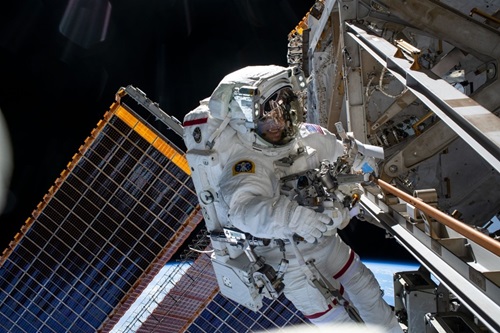EVA 101: Life Support Systems – Online Short Course (Starts 9 Sept 2024) 9 September - 18 November 2024 Online

- From 9 September – 18 November 2024 (7 Weeks, 10 Classes, 12 Total Hours)
- Week #1. Mon, 9 Sept & Thurs, 12 Sept
- Week #2. Mon, 16 Sept & Thurs, 19 Sept
- Week #3. Mon, 23 Sept
- Week #4. Mon, 30 Sept
- Week #5. Mon, 7 Oct & Thurs, 10 Oct
- Week #6. Thurs, 24 Oct
- Week #7. Mon, 18 Nov
- Classes from 2–3:15 p.m. ET USA (all sessions will be recorded and available for replay; course notes will be available for download)
- EVA 101: Life Support Systems will familiarize the student with the essential features of life support systems required for various types of space missions and will cover the requirements and design considerations for life support systems in space.
- New joint course with the International Institute for Astronautical Sciences (IIAS)
- All students will receive a joint AIAA/IIAS Certificate of Completion at the end of the course.
OVERVIEW
EVA 101 will familiarize the student with the essential features of life support systems required for various types of space missions. This course covers the requirements and design considerations for life support systems in space. Included are an introduction to basic human physiology, a description of the space environment, a survey of historical life support systems, and a presentation of spacecraft limitations and requirements. The course concludes with an introduction to EVA space suit operations with the Final Frontier EVA space suit.
LEARNING OBJECTIVES
Upon completion of the course students will be able to:
- Describe those attributes of human physiology requiring protection during space flight with specific reference to the cardiovascular, fluid and skeletal systems.
- Describe the impact of the psychological effects of long duration space flight.
- Describe the evolution of life support systems from Mercury to the International Space Station.
- Identify each of the 6 sub-systems of the ISS life support system and describe what each does with reference to specific sub systems within each sub system.
- Discuss the role of air and water reuse in long duration space operations with particular reference to the concept of a closed life support system.
- Describe the space environment, and describe protection techniques for humans against solar flares, galactic cosmic rays and microgravity.
- Review and list the limitations placed on logistical support and life support requirements on the major NASA space projects (Moon, DSG and Mars missions).
- Briefly discuss future life support requirements for missions beyond Earth orbit, including extended stays on the lunar surface and manned missions to Mars. Explain the rationale for human phenotyping, genetic manipulation and human hibernation in the context of long duration missions.
AUDIENCE: Professionals, graduate students, upper-division undergraduate students.
TEXTBOOK: Life Support Systems for Humans in Space, by Erik Seedhouse
COURSE FEES (Sign-In To Register)
- AIAA or IIAS Member Price: $995 USD
- Non-Member Price: $1,195 USD
Classroom hours / CEUs: 12 classroom hours, 1.2 CEU/PDH
Cancellation Policy: A refund less a $50.00 cancellation fee will be assessed for all cancellations made in writing prior to 7 days before the start of the event. After that time, no refunds will be provided.
Contact: Please contact Lisa Le or Customer Service if you have questions about the course or group discounts (for 5+ participants).
- Week 1. Life Support Systems Overview/Introduction
- Week 2. The space environment
- Cosmic Perspective
- The Space Environment and Spacecraft
- Living and Working in Space
- Week 3. Life support system basics
- Life Support System Basics
- International Space Station Environmental Control and Life Support System
- Week 4. Physico-chemical life support systems Part I
- Exploration Life Support Overview and Benefits
- Week 5. Physico-chemical life support systems Part II
- Introduction to Bioregenerative Life Support Systems
- An Analysis of Hybrid Life Support Systems for Sustainable Habitats
- Developing the technology of physicochemical processing of organic waste in closed life support systems for space applications
- Week 6. Bioregenerative life support systems
- CAB: The bioregenerative life support system. A feasibility study on the survivability of humans in a long-duration space missions
- Past, Present, and Future of Closed Human Life Support Ecosystems – A Review
- MELiSSA: the European Bioregenerative Life Support System project
- Week 7. ISS and spacecraft life support systems
- ISS Life Support System
- ECLSS
- Environmental Control & Life Support Systems for Human Spaceflight
- International Space Station Environmental Control and Life Support System
- Week 8. Future life support system
- Hibernation
- Torpor
- Waterwalls
Course Delivery and Materials
- The course lectures will be delivered via the IIAS GoToMeeting Webinar Service.
- All sessions will be available on-demand within 1-2 days of the lecture. Once available, you can stream the replay video anytime, 24/7. All slides will be available for download after each lecture.
- No part of these materials may be reproduced, distributed, or transmitted, unless for course participants. All rights reserved.
- Between lectures, the instructors will be available via email for technical questions and comments.
AIAA Training Links
For information, group discounts,
and private course pricing, contact:
Lisa Le, Education Specialist (lisal@aiaa.org)
